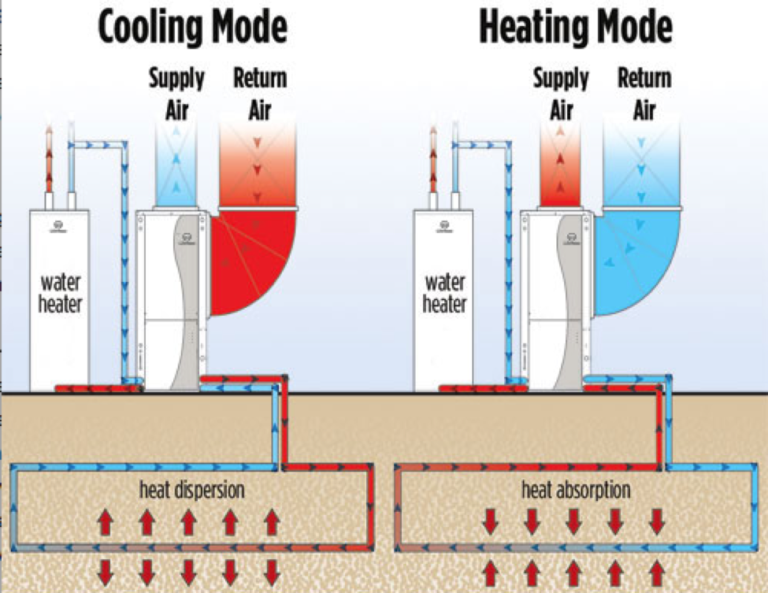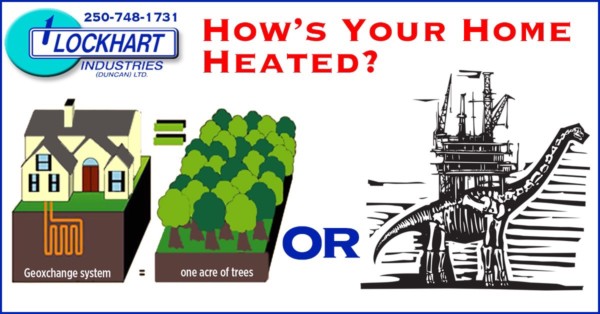Vancouver Island GeoExchange (GeoThermal) Heating & Cooling
At Lockhart Industries, we are BC GeoExchange / GeoThermal experts. We say we’re GeoExchange experts in British Columbia specifically because every climate is different and we’re specialists at installing GeoExchange systems in our wonderfully temperate BC climate.
Although this page is about geothermal heating in BC or more specifically, on Vancouver Island, we’ll start with a general overview about the different methods of heating your home.
There are generally 6 main ways to heat a house these days:
- Furnace – heats air and distributes it throughout the house
- Boiler – heats water and uses it or steam to heat the house
- Heat Pump – pulls heat from the surrounding air to heat the house. Can also be used for cooling
- Electric Heating (baseboard heaters) – one of the most expensive ways to heat your home, this is any method that uses electricity and converts it to heat
- Wood Stove – burning either wood or pellets to heat a home
- GeoExchange – using the earth’s power to heat and cool a house
What you should know from the onset is that every method of heating your home has its pros and cons. From the cost to the air quality to the aesthetics and many things in between, what we’ve found in our many years is this business, is that different things matter to different homeowners.
GeoThermal Heating Background & Information
Geothermal energy has been used as an energy source to heat and cool buildings for several decades now. Technically, GeoExchange is the correct term for this method of using the earth or water to heat and cool your home, but it’s been known by many names in the past (in addition to GeoExchange and GeoThermal) including: ground water source, ground water assisted, water to water, ground source heating etc.
Well, now that you know the different ways to heat your home as well as some of the different GeoExchange type terminology, let’s get into the meat of things and talk about how geothermal systems actually work.
How Geothermal Systems Work
We know that GeoExchange (geothermal heating / cooling) systems use the earth’s energy to both heat and cool. It can do this due to the fact that the temperature of the ground stays fairly consistent throughout the year as opposed to the outside temperature which changes dramatically.
An explanation of how GeoThermal systems work is easiest with some imagery.
In the image below, you can see a basic geothermal system using a ground loop. It also shows how the same setup can be used to cool your house for free in the summers. The ability to provide air conditioning is actually a by-product of the heating system and so it’s technically free.
Facts About GeoThermal Heating (aka GeoExchange Heating)
A GeoExchange system:
- Can pre-heat about 60% of hot water needs
- Is more efficient and will typically run on Southern Vancouver Island at a further 50% savings compared to Air to Air heat pumps
- Is 400-500% more efficient than fossil fuels
- Will typically last 20-25 years – longer than any other heating system
- Has lower maintenance than any other heating system
- Has no outdoor unit and accesses it’s ‘free heat’ from the ground, pond, lake or ocean – a limitless supply of ‘free’ energy.
- Can heat air or water for either a forced air or in-floor heating system
- Can do combined forced air and in-floor heating (as well as domestic hot water)
Benefits of GeoThermal Heating
The Operating Efficiency of GeoExchange Systems
More than two-thirds of the energy supplied by a GeoExchange unit is renewable energy taken from the ground. The other third comes from the electricity used to power the system. You only pay for the electricity you use to operate your system. The other two thirds is free.
Let’s look at the efficiency of one heating system over another.
Fossil fuel furnaces shoot the products of combustion up the chimney (CO, CO2, SO2, NOx, etc) thereby allowing some heat to leave the house. Older style furnaces, the ones with pilot lights, burn a small amount of gas continuously – even when your home does not need heating. If you are using an old gas or oil furnace, you can be venting as much as 35 to 40 percent of the fuel you have purchased up the chimney.
Oversized furnaces might waste even more energy than that as they reach operating efficiency just as the thermostat has been satisfied and has subsequently shut off.
Since electric furnaces and baseboard heaters don’t require a chimney, all their energy stays in your home – even if the electric motor distributing air through your home is not very efficient.
An electric furnace or baseboard system can therefore be considered 100 percent efficient (although very costly to run).
There are no combustion products created with a GeoExchange system. Like an electric furnace, the electricity used to run the pump, fan and compressor stays in the house. A geo system operates at more than 100 percent efficiency because it takes additional energy from the ground – more than you put into it.
Year Round Comfort Exists…with GeoThermal Heating & Cooling
You know what we hear often from our GeoExchange customers? Our customers who live in homes with a GeoExchange system often say, “In all the homes we’ve lived in, this is, by far, the most comfortable.”
There are a couple different reasons for that statement. First is that the air temperature a GeoExchange system produces is around 35°C and doesn’t waver much. In contrast, a fossil fuel or electric furnace typically heats a room up as high as 50-60°C to get the house to right temperature. This creates differences of 3–4°C in certain areas of the house – known as hot spots.
I’m sure you’ve had times in your own house where one minute you’re putting on a sweater and the next you’re taking it off. This is a good example of what I’m talking about.
5-star Google Review for Geothermal Heating and Cooling Solution Installed by Lockhart Industries
I first learned about geo thermal heating when Doug Lockhart installed a large system in a industrial shop .I had him advise me and later install a system for our home as the shop one worked so well.Our system gets water from our well and has been running for 9 years .I would do it the same way if I were to build again.
Environmentally Friendly Heating & Cooling with GeoExchange — Yes, it does exist.
Did you know that 2/3rd (or more) energy a GeoExchange system delivers to your home is renewable solar energy (which is stored in the earth). This is good for both your wallet and the environment as toxic emissions are virtually non-existent in a GXS system.
Depending on various factors such as climate, a GeoExchange system gives back 3-6 units of energy for every 1 paid to BC Hydro.
Getting energy to your home is one of the largest parts of the expense for heating it. Whether it’s electricity, gas or oil, the infrastructure is expensive to build and maintain – a cost that’s passed onto the consumer. Some of these costs include direct expenses like the building and maintaining of the pipelines and transmission lines but also other costs like dealing with emergencies / outages etc.
Not only is the required infrastructure for conventional heating expensive for you – it’s also very costly to the environment.
GeoExchange, however, moves most of your home’s energy no more than a few hundred metres. The only real transportation costs associated with a GeoThermal system is the cost of running the circulating pump.
GeoExchange Systems – Low Maintenance, Long Life
Let me explain why a GeoExchange system is very low maintenance and long life.
The heat pump in a GeoExchange system works similar to the heating coil at the back of your fridge. The only significant difference, other than capacity, is the addition of a reversing valve that allows your GeoExchange system to cool your home and send the heat out of your house and into the earth. The compressor of a heat pump is similar to, but much larger than, a fridge compressor.
The only other moving parts are the blower motor and the pump to circulate fluid through pipe buried in the ground. Unlike an air source heat pump, the equipment is located inside your home – not exposed to dust, rain, snow and extreme temperatures. If the system (i.e., the earth loop and the distribution system) is designed to match the needs of your home, it will operate with very little maintenance, much like your refrigerator. The only regular maintenance you will have to do is to make sure the air filter is clean (if you have a forced-air system).
More GeoExchange System Benefits
- Heating Domestic Hot Water
Heating the water for your home is likely the largest monthly expense for homeowners next to space heating. This functionality of heating hot water, however, can be added to your heat pump. Depending on how much water your household uses, this system can provide 30 to 60 percent of it for free.
- Non-Intrusive & Quiet
Unlike a conventional heat, there is no outdoor condensing unit to annoy neighbours or dinners on your patio. The condensing unit can be located in a garage, basement, or crawlspace for a quiet running system.
- Protected from Vandalism and Weather
All of the components of a GeoExchange system are inside so they are protected from both weather and vandalism.
Cost of GeoThermal Heat Pumps
Whenever the conversation turns to geoexchange systems, the subject of cost is one of the first to come up. Fair enough – the cost of any major investment should be evaluated on a case by case basis to determine if it’s the right investment, at the right time, for each individual.
A geoexchange / geothermal system is not cheap – at least not upfront anyway.
That being said, let’s get into the nitty gritty of numbers for geoexchange systems. Please keep in mind here that these are only estimates and that your house could end up costing less or more than this as each geoexchange unit is custom designed, built and installed by our team.
The problem with trying to give the typical cost of a geoexchange system is that no two units are typical. When retrofitting a house, it’s impossible to give an estimate as there are just too many variables that come into play.
For a new construction, the numbers are a little easier to run. For a new install in a 2500sq ft house, a “typical” geoexchange unit will cost in the neighbourhood of $35,000.
I’ll give that a minute to sink in. 35k is no small amount of money. It’s only when you run the numbers yourself, on your particular home – and combine that with all the facts – only then will you know definitively whether a geothermal unit is right for you.
Since running a geothermal system is up to 80% cheaper than fossil fuels – and gives back 6 units to every 1 that you pay hydro for – these systems typically pay for themselves in 5-8 years vs 12-15 years for fossil fuel systems.
It should be mentioned here that these units can be financed and by doing so, some of our customers are almost able to pay their entire monthly financing charge with the savings in hydro costs that they experience from their new geo unit each month.
The Payback on a GeoExchange / GeoThermal System
One of the most common questions people ask is, “If I buy a GeoExchange system, what’s the payback?” There are a lot of factors to take into consideration but for the purposes of illustration, let’s look at Jim and Donna’s situation. This case study is taken directly from a great geoexchange resource that you can download here from the Canadian GeoExchange Coalition.
Jim and Donna are planning a
160 m2 / 1725 sq ft house on a large suburban lot. They want to heat their home as inexpensively as possible. Natural gas is not yet available, but there has been talk of extending the gas lines past their property in the next year or two.
They are considering an electric furnace, a propane furnace that can be converted to natural gas in a year or two, and a GeoExchange system.
Here are quotations for all three options:
| Electric furnace and air conditioning | $9,000 |
| High-efficiency propane furnace and air conditioning | $11,000 |
| GeoExchange System | $23,000 |
The estimated annual fuel costs are as follows:
| Heating | Cooling | Hot Water | Total | |
| Electric furnace | $1,980 | $195 | $452 | $2,627 |
| High-efficiency propane furnace | $2,660 | $195 | $607 | $3,462 |
| High-efficiency gas furnace | $1,213 | $195 | $276 | $1,684 |
| GeoExchange System | $619 | $94 | $283 | $996 |
A simple payback is one of the easier ones to calculate. Just take the cost of installing the system you’re comparing against from the GeoExchange system install cost, then divide that by the fuel cost savings.
As an example, if we’re comparing against an electric furnace, the simple payback is ($23,000 – $9,000) ÷ ($2,627 – $996) = 8.6 years.
Now, let’s dive a little deeper with a cash flow analysis which will show you how the numbers work over a 20-year period (that’s when the numbers get really interesting).
Cash Flow Analysis on a GeoThermal / GeoExchange System
A cash-flow analysis shows you your cash outlay each year for owning and operating a system. If you are financing the cost of your home over a 20-year period, the cost difference to install the heating and air conditioning system is financed as well.
| Energy Cost | Annual Principal and Interest (5%) | Total | |
| Electric System | $2,627 | $712.80 | $3,339.80 |
| GeoExchange System | $996 | $1,821.48 | $2,817.48 |
| Annual cash-flow savings with a GeoExchange system | $522.32 | ||
You can see that the higher initial cost of a GeoExchange system is offset by the difference in annual energy costs. Add to that monthly energy costs of the two systems as well as your monthly mortgage payments and you’re making an extra $43.53 each month ($522.32 ÷ 12 months).
Then take inflation and continually rising fuel prices into account and you’re going to be saving even more.
Of course, when you take inflation or rising fuel prices into account, your savings are even higher. If we took this analysis even further – with a life cycle cost analysis – the real numbers become apparent because then you factor in long-term maintenance and lifespan of the units.
GeoExchange Lifetime Savings
A life-cycle cost calculation takes the cash-flow analysis a few steps further, by adding the cost of inflation on fuel, the cost of replacing your equipment at the end of its expected life, the cost of borrowing the money to install the system and other costs.
These costs are typically estimated over a 20-year period and are relatively complex to calculate.
But the following points are worth noting:
- The estimated life expectancy of the heat pump in a GeoExchange system is approximately 18 to 20 years, or about the same as a conventional furnace. A conventional air conditioner or air-source heat pump can be expected to last only 12–15 years, because the outdoor unit is exposed to the weather.
- The earth loop can be expected to last 50–75 years. Even if the heat pump needs replacement after 20 years, the earth loop can be expected to last much longer.
- If the cash-flow analysis shows that your annual savings are $522.32 per year now, inflation will increase the value of the savings with the fuel inflation rate.
- If you were to invest the annual cash-flow savings in an RRSP at 2.5% interest, assuming an annual inflation of 2.5% on the energy costs, the annual cash-flow savings of your GeoExchange system would grow to be worth $24,402 after 20 years.
So there you have it – the real savings of a GeoExchange system is $24.5k over the lifespan of the unit.
Not too bad huh?
Click HERE if to see all of this information boiled down in our Geothermal Infographic
More information about geothermal heating for your home or commercial business:
GeoExchange/GeoThermal for Commercial
An Explanation of GeoExchange Systems
GeoExchange for Aquaculture
Loop Types
Combining Geo with Solar
GeoExchange video explanation
Easy Financing with…
Start Saving Money NOW! There’s no need to putting off a more Energy Efficient, Cost Effective home comfort system. We make it simple!
With Financeit you can:
- Make additional payments any time without penalty.
- Get a lower payment by choosing an amortization period of up to 180 months. 7.99% to 11.99% interest rate.*
- We add a small fee to the loan amount. There are no hidden or additional charges
- Bank-level encryption (AES-256 bit SSL) to protect your personal information.





